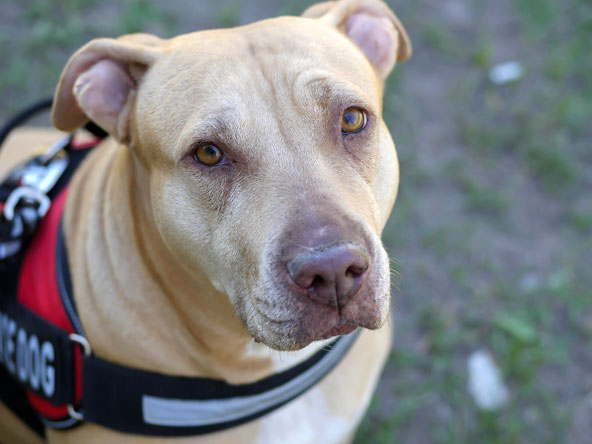Posts in Category: Pet Tips
Celebrate Walk Your Pet Month

The lovely Chicago weather this time of year can make it challenging to be excited about taking your beloved four-legged friend for a walk. Lucky for you, it’s National Walk Your Pet Month! This is the perfect time to get motivated to get up and get moving!
You may have made your New Year’s resolution to get healthier, which may include walking more. Take your dog along and work on your resolutions together. What a great way to start 2018!
Exercise is very important in helping your pet live a healthy and long life, and walking your dog can actually help you to meet your own fitness goals. Research has found that people who walk with dogs are more consistent in their exercise routine than those who walk with a human—what could be a better way to burn off those holiday calories?
Benefits of exercise:
- Improves strength, fitness, flexibility, and movement
- Increases energy levels
- Helps decrease stress and can help improve your and your pet’s mood
- Improves sleep
- Builds your pet’s social skills and familiarity with the surrounding area
- Prevents pet’s boredom by providing mental and physical stimulation
- Decreases pet’s bad behavior and aids in training
- Improves the bond between you and your pet
- Prevents obesity
The type and amount of exercise needed can differ greatly with breed, age, and energy level. Low-energy dogs usually need about 30 to 45 minutes of exercise a day, while higher energy dogs may need hours of exercise a day.
Cats, too, need daily exercise and setting aside 15 to 20 minutes a day for interactive play will help keep your cat happy and healthy. Cats are nocturnal animals, which means they are at their most active at night. Training them to exercise during the day will help you and your cat sleep at night. Cats enjoy exercise such as stalking, pouncing, climbing, and hiding.
Below are some tips for improving the experience of walking your dog:
Walking Your Dog Is Bonding Time
Walking together is a great time to focus on training your dog and strengthening the bond between you. To get the most out of your time together, don’t walk and talk on the phone. Use this time to focus on your pets. They spend a lot of time alone already and need you. Praise them when they walk well and pay attention to you.
Safety after Dark
During the winter it gets dark early. If you normally walk your dog before the sunrise or late afternoon/evening hours, you want to make sure you can be seen by motorists, bicyclists, and other dog walkers/pedestrians. A lighted leash and collar combination is good for your dog. You will do well to wear light-colored clothes or, better yet, a reflective vest or jacket.
Bring the Necessities
Make the walk pleasant for you and your dog. Always carry bags for cleaning up and disposing of doggie poop. Don’t forget to hydrate, carry water for yourself and your dog, especially in warmer weather. Dogs can lap water from your cupped hands, or you can carry a collapsible water bowl. Don’t forget to pack your dog’s favorite bite-sized treats for rewarding good behavior!
Change It Up
To make walks more fun for you and your dog, rove a little—and travel off the beaten path by taking your dog on different routes, going to cool places like the dog park or a friend’s house (preferably a dog owner!), and taking walks with buddies—borrowing a friend’s dog or asking another owner to join you on your walk.
So grab that leash and take your friend for a stroll! It’s ALWAYS a beautiful day for a walk!
Amber Slaughter, DVM
Medical District Veterinary Clinic
Pet Owner’s Guide to the Holiday Season

Thanksgiving has come and gone, and despite the date on the calendar, we are grappling with 60-degree Chicago weather. This helps make the Hallmark Channel’s holiday movie marathon seem a tad bit more inappropriate than normal and also augments my somewhat resentful feelings about premature holiday music leaking from every single possible place in the world. And again, I feel the need to be the sobering voice of reason that addresses the dangers posed to our pets by the holiday season.
But before I address holiday-specific problems, let me say this: The high today is 62 degrees. This is hotter than September. If you are the type that loves this, you are in the same company as all the fleas, ticks, mites, intestinal parasites of Chicago that are feasting on your animals. Mosquitoes are few, but still present; please consider using your flea/tick and heartworm preventatives. We have been inundated with flea infestations, sudden outbreaks of suspected skin and GI allergies, and all it takes is a few pills a month to not have to worry about this. If you’ve been seen within the year, you don’t even need to come in, you can just call for a prescription refill.
Holiday Dangers
It’s always a bit misleading to think that various times of the year are more dangerous for our pets than others, but there are some specific things we should think about and address in order to keep our beloved cats and dogs safe and happy, especially as our minds drift to holiday gift lists, vacations, and the slew of abnormal scheduling that occurs during December.
In no particular order:
Gift Wrapping
Cats eat ribbons. Cats love ribbons. Cats are not meant to eat ribbons. If you have a cat, just avoid ribbons. If you get a gift with ribbons, throw the ribbons away immediately. Don’t give gifts with ribbons to someone with cats. At the risk of disrupting the ribbon industry, I would be happy if ribbons were banned from holiday traditions.
Christmas Trees
Dogs and cats eat tinsel, which can, minimally, cause stomach upset (diarrhea, vomiting, pain) and, maximally, cause foreign body obstruction. Dogs and cats also like to chew Christmas trees and wreaths. We have had a few cats, recently, come in for allergic reactions to glue or fake snow sprayed on wreaths. There is no great way of preventing your animals from getting to these things unless wreaths are hung in places they can’t get to and the tree is put in rooms that can be closed when you are not there to monitor. More seriously, you have to be careful that pets do not chew lights and ornaments. Electrocution is possible, causing serious or even fatal effects. Ingestion of glass ornaments can cause severe mouth and gastrointestinal bleeding. And then as if this slew of fears isn’t enough to make you anxious, always remember that animals can knock over trees, causing damage to themselves and your house. On a lesser note, I think that every cat and most dogs are very tempted to defecate and urinate in the Christmas tree. Plan on needing some extra scented candles to mask the holiday urine and feces smell-fest.
If you are the sort to wrap gifts of food for your loved ones and place them under the tree, please understand that your animals do not respect the lovely ceremonial waiting-until-Christmas-morning to find out what is there. We’ve seen people put candies in stockings, meat products in boxes, and cakes and treats in bags, all to find everything gone in the morning. The subsequent and joyous Christmas morning ER visit may then be needed.
Hanukkah/Kwanzaa Candles
This also applies to all candles, but make sure to keep all lit objects away from animals that are curious or could be curious to jump on the table and knock it over or be burned. Hanukkah candles are not supposed to be extinguished for any reason, so that may mean making sure you don’t buy candles that last for hours. (Hint: the cheaper they are, the faster they burn.) Although it may enrage the rabbinical community, just blow out your candles if you can’t be near them for their full-lit life. Better to risk the wrath of your rabbi than to burn down your house or burn off your cat’s whiskers.
Treats
Cookies, cakes, pot roast, candied hams/yams, candy. Your animals want all of this. If you bake a cake and then set it down to go check on the kids, your dog will eat it. Your cat will jump on the counter and lick frosting from a bowl. They are probably working together to distract you. Also giving your dog a lick of turkey or ham juice may seem like a wondrous holiday gift, but if everyone at dinner or in the house does the same thing, you will be finding that diarrhea, pain, vomiting, and a trip to the ER may also be needed to take care of gastroenteritis or pancreatitis. As always, be super careful about chocolate. The bottom line is this: Dogs and cats are a part of our lives and we want them to participate in our holiday fun. But they do not need to eat special things. Put a bow on their normal food or arrange their wet food in the shape of a Christmas tree. They will be happy. I also feel like admitting that I just gave my dog a birthday can of special food and dealt with him having diarrhea for three days.
Plants
Poinsettias can cause gastrointestinal upset (especially if a large amount is eaten), as can mistletoe and holly. More serious is ingestion of decorative lilies and daffodils by cats. Christmas/peace lilies can kill cats. Daffodils are less deadly, but can cause severe irritation. Just be careful of ingestion of anything abnormal in the house.
Pet Anxiety
Leaving the house for the day, bringing your dogs/cats to the in-laws, having the new downstairs neighbor check up on the animals … all these things can cause anxiety and secondary stress. Remember that our animals do not always find travelling, new novel environments with new smells, animals, kids, and so forth, or being alone or with strangers taking care of them fun. If you have a sensitive dog or cat, try having the caretaker come over a few times before you go to meet the pet and make the pet more comfortable. If you need to go out of town, consider finding another alternative such as leaving your pet with people they already know and trust. If you are going to be gone for longer than normal, make sure they have ample food and water. If they already suffer from known problems (like GI sensitivity), consider being proactive and giving them gastroprotectants (with our approval) before they get sick. Also think how a giant tree with flashing lights and noises in their favorite corner of the living room may affect their mood and security.
General Cold Weather Wintering for Our Pets

Firstly, remember that your little 20-pound short-haired dog needs to be dressed for winter when going out. Not all of us have Alaskan malamutes and Siberian huskies. A quick trip around the block in 0-degree weather can be dangerous and uncomfortable. Get some nice winter clothes at the pet supply store or online NOW before it becomes horrible outside. Also be careful about the temperature of your home. Maybe this is your first year with a pet and you are used to turning down the heat to 62 when you leave for work. Your little short-haired kitty may be really uncomfortable with that temperature. All pets are different, so talk it over with us, or assess on your own that they are doing their normal things like playing, eating, and drinking.
The salt on the sidewalks can cause serious irritation and harm to animals. I like using Mushers Wax on dogs’ paws that become irritated. The wax also helps protect paws from the cold, to a degree. You can get this online or most pet supply stores.
The cold weather makes a dog’s normal outdoor activities (walking, playing in the yard, socializing with other dogs) less frequent. Take seasonal depression into account when thinking about how your pets feel without these normal stimuli. Come up with some new indoor rituals to replace that extra walk, such as fetching, wrestling, or various games. Try having play dates with other (fully-vaccinated) dogs with whom your dog gets along. This doesn’t really apply as much to cats, but you should be doing this with your cats anyway.
With winter weather comes the use of anti-freeze in cars. Just be very careful and remember how toxic this is to all animals and humans. If you spill anti-freeze in the garage, DO NOT let your dog go in the garage. Do not leave anti-freeze around unopened. Do not throw out any rags with anti-freeze without securing them in a container that would be hard to eat or lick. Be careful of the feral or stray cats that may also seek sanctuary in your garage and also can die from exposure.
Also, despite the projections for a cold Chicago winter, fleas and ticks are still around (see above). We’ve been treating many dogs this season already for such. Ticks can live when it is above freezing. If you decide to go on a holiday hike in the forest preserve during a 40-degree Saturday, your dog still can have tick exposure. You cannot always see ticks, but they are there.
Lastly, New Year’s Eve in a city is always loud, and most pets do not like the secondary outbreak of fireworks, pots and pans, screaming, and (in our case) Scottish bagpipes being played for hours outside our window. Dr. Kelly Ballantyne, the veterinary behaviorist at our location, discussed this issue. In general, remember that having anti-anxiety medications can be very helpful for this situation. Just being careful and aware can help the situation from getting out of hand. Closing windows, using white noise distractors, or just being attentive and helping your pets get through the countdown on New Year’s Eve can really help. The most common side effects of severe stress are gastroenteritis (vomiting, diarrhea, inappetance), self-trauma (licking, biting), and sometimes aggression toward other animals or owners.
Thanks for reading. I hope your holidays are wonderful and stress-free for you and your pets. We like receiving pet holiday cards, in case you are the sort to send them out to people.
Brett Grossman, DVM
Medical District Veterinary Clinic
Greyhound Overcomes Rare Condition

A rare but life-threatening condition called “exertional rhabdomyolysis” recently afflicted a patient of the Medical District Veterinary Clinic at Illinois.
This complicated term refers to extreme muscle damage that occurs as a result of short, high-intensity workouts. Affected animals may appear dehydrated, painful, weak, disoriented, and nauseous. Rhabdomyolytic attacks can happen to any animal or person after extreme or unaccustomed exercise, but it is most commonly diagnosed in racehorses.
Our patient, Kora, is a young retired racing greyhound that was hospitalized with this condition.
The problem arose on a gorgeous, cool (75 degrees F) Saturday afternoon. Kora was playing and romping around at a 3-acre dog park. Several dogs were chasing a remote control car at the park. With Kora’s background in racing, she was likely trained with remote control cars, and she chased the car at racing speeds for 5 to 8 minutes, catching it multiple times.
After less than 10 minutes of chasing, it was clear that Kora had injured her paw, and she seemed to be panting excessively. Her parents packed up Kora and her brother Charlie, and they returned home. Once home Kora was given water and a fan to help her cool down, but it took almost an hour for her to finally calm down. About 2 hours later, she was unsteady and her urine was very dark in color.
Not knowing what was going on but thinking she may be suffering from heat exhaustion, Kora’s owners took her to a 24-hour emergency clinic. What they thought was mild dehydration and heat exhaustion turned out to be much worse.
The severe muscle injury/damage that occurred during that short 5 to 8 minutes of chasing the remote control car caused the release of muscle breakdown products, myoglobin and potassium. Having excess potassium in the body can result in irregular heartbeats, and myoglobin is known to cause acute kidney failure. The myoglobin was responsible for the brown-colored urine.
 Because of these serious consequences, Kora was hospitalized for two days on intravenous fluid therapy to help correct electrolyte imbalances, correct dehydration, and flush her kidneys. In addition to IV fluids, Kora was treated with muscle relaxers and pain medications, as she was very sore for many days.
Because of these serious consequences, Kora was hospitalized for two days on intravenous fluid therapy to help correct electrolyte imbalances, correct dehydration, and flush her kidneys. In addition to IV fluids, Kora was treated with muscle relaxers and pain medications, as she was very sore for many days.
More than a month since her initial injury, Kora has slowly been returning to normal activity. She was restricted to leash walks for almost a month while her blood values were closely monitored.
I am happy to report that Kora has no long-term kidney damage from this condition because of the quick intervention of her parents. She was started on fluid therapy in time to prevent permanent kidney damage. While she did lose a lot of muscle mass along her back and rear legs, she is gradually rebuilding the muscle.
As a dog owner, you may be wondering if you should prevent your dog from running at the dog park to prevent an injury like Kora’s. Exertional rhabdomyolysis is a very rare condition and usually only affects animal athletes that have been away from intense training for a while and then jump back in with too much volume and intensity.
The most common dogs affected would be retired greyhounds and retired sled dogs, so unless you have one of these dogs, you probably do not need to be worried about exertional rhabdomyolysis. If you do have a greyhound, it’s important to never let him/her run at racing speeds for more than 30 seconds at a time. On the track, a greyhound race lasts between 30 to 40 seconds, where the dogs are running at top speed. So if you do take your ex-racer to a dog park, make sure they’re only running for fun, not for speed!
Drew Sullivan, DVM, Director
Medical District Veterinary Clinic
Note: Kora’s recovery was the result of teamwork between multiple veterinarians. Kora’s owner not only worked with Dr. Sullivan after being hospitalized on IV fluids but also worked directly with Dr. Jenifer Barker (a greyhound veterinarian in Wisconsin who spent years treating greyhounds at the race track).
Honoring Service Dogs

September is National Service Dog Month, which is all about honoring the hardworking dogs that serve individuals with disabilities of all kinds. It is also meant to celebrate the people who contribute to their success. In honor of this special celebration, below are some interesting facts about service dogs.
- Service Dogs Can Be Any Color, Size, or Breed
There’s nothing that says Service Dogs can only be Labrador retrievers, golden retrievers, or German shepherds. While those three breeds are some of the most commonly seen service dogs, absolutely any dog with the proper temperament, good health, and structure, and the physical capability to do the job their person needs them to do can be a service dog, regardless of color, size, or breed.
- Service Dogs Come in Multiple Varieties
Everyone knows what guide dogs are, and most people have heard of hearing dogs. People often know immediately that a dog wearing a special harness and partnered with an individual in a wheelchair is a service dog, although they may not know exactly what that dog does for its person. However, there are well over a dozen distinct varieties of service dogs, including, but not limited to:
- Allergy Alert Dogs
- Autism Assistance Dogs
- Brace and Mobility Support Dogs
- Emergency Medical Response Dogs
- Diabetic Alert Dogs
- Hearing Dogs
- Guide Dogs
- Medical Alert Dogs
- Medical Assistance Dogs
- Medical Response Dogs
- Psychiatric Service Dogs
- Seizure Alert Dogs
- Seizure Assistance Dogs
- Seizure Response Dogs
- Visual Assistance Dogs
- Wheelchair Assistance Dogs
- Service Dogs Aren’t Just for Emotional Support
Service dogs don’t just offer companionship and emotional support to their people. In fact, any dog that does that and only that isn’t a service dog — it’s an emotional support dog. In order to be a service dog, a dog has to possess specialized training that mitigates some part of its handler’s disability. It can’t be a behavior the dog offers naturally, either, since that isn’t a trained behavior. It must be a specific, predictable behavior tied to a cue or trigger that the dog performs reliably in order to be considered trained task work.
- Service Dogs Perform Specialized Work and Tasks for Their Person
Service dogs possess specialized training that mitigates their person’s disability. Depending on the type of service dog, the dog may have anywhere from three to a dozen different tasks or even more! Some examples of service dog tasks include:
- Retrieving dropped items
- Opening and closing doors
- Turning lights on and off
- Pulling a wheelchair up a slope
- Licking a seizing person to help end the seizure via tactile stimulation
- Alerting a diabetic person to dangerous shifts in blood sugar
- Bracing an unsteady or unbalanced handler
- Service Dogs Aren’t Required to Wear Gear
In the United States, there is no required gear for service dogs. A service dog is a service dog regardless of what it is or is not wearing, and its handlers possess the exact same access rights with or without their dog in gear. Vests, harnesses, and jackets are very commonly seen on working service dog teams, but by law, the dog isn’t required to wear anything in order to work in public.
To support service dog programs, and help continue this extremely valuable work, please consider donating your time or money to a local service animal training and advocacy organization.
Amber Slaughter, DVM
Medical District Veterinary Clinic
Understanding Respiratory Allergies in Your Cat or Dog

The factors that affect your animal’s comfort and happiness are multitude. We commonly focus on how to enrich our animals’ lives by making sure they have stimulation and entertainment. We race home from work to make sure they are walked or fed before dark. We have cat sitters come over three times in a day so they won’t get lonely. We buy special treats to reward our dogs for shaking our hands. We turn on their favorite songs, paint their nails, comb their hair, and spend endless amounts of money on the only type of chicken stew they find tolerable. It is sometimes easy to forget, though, that simple things affect them greatly, and while we go to such great effort to care for them, it is easy to lose sight how often controllable allergies are the root of issues.
Both cats and dogs are affected by common allergens that may go unnoticed and cause irritability to their skin, their digestive system, their joints, and their overall comfort level and associated behaviors. I want to focus briefly on respiratory allergery, as it is a common and often undertreated disease that affects many animals, especially at key times of the year.
Feline Allergic Asthma/Canine Sterile Bronchitis
Most of our cats remain inside, so this is something that is a little more controllable. Cats that are exposed to allergens such as second-hand smoke, cleaning products, perfumes, remodeling debris, other cats and dogs visiting, and fleas can start to develop clinical signs similar to what you would see in humans with asthma. It may start as some mild wheezing (most people report snoring), then some mild exercise intolerance, and then a slow increase in respiratory rates that seem inappropriate to the usual. Coughing can occur.
Dogs tend to go outside and thus are exposed to more allergens at an early age. Though this can be helpful in increasing the immune system’s palate, it also can expose them to things about which they never would otherwise need to worry—decorative flowers, grasses, chemicals, firework debris, garbage, street water, exhaust, construction debris, etc. We see a lot of smaller animals prone to other respiratory issues (like our pugs and bulldogs) be especially sensitive to these issues. Dogs exhibit the same signs with the added, sometimes secondary, hack or cough that is more common.
Though this can start when animals are young, they usually start to develop issues on the second time around the season cycle. It also can sometimes start out of nowhere later in their life as their immune system becomes stimulated by new exposures or stresses (like moving). We see a lot of transplants from other states find their otherwise healthy cat that has never been exposed to a coat full of ragweed and is now triggered into an allergic event. Changing apartments to another part of the city, or simply moving into an area that might have recently gone under construction or been cleaned can also do this. Seasonal apartment cleaning is one of the more common factors in allergic dogs and cats. If you live in a building complex with shared air ducts, a neighbor smoking, cleaning, or redesigning their kitchen can cause issues.
Though treatment can be simple, it may take some work to properly diagnose allergies. There are many, more serious causes of respiratory issues so it is always recommended to have your cats and dogs seen to make sure there are not underlying issues also causing problems. Metabolic abnormalities, infections, heart disease, pain, among many issues can all cause similar clinical signs. Another key component to controlling these issues is to deal with them quickly. The inflammation secondary to allergies is a cellular event that can be controlled with anti-allergy medicine and anti-inflammatories (like temporary and very low doses of steroids). The longer allergies go untreated, the harder it is to come out of them, not to mention the longer your dog and cat will suffer through unneeded discomfort. Often, secondary infections come after the allergies. This must be addressed as a separate issue.
Tips to Help after Your Animal Is Diagnosed and Properly Treated
- Change your heating and air-conditioner filters. If you do not know where your heating and/or air-conditioning filters, then they probably need to be changed.
- Clean regularly, rather than go long periods of times without dusting, cleaning the floors, blankets, etc. This includes curtains, beddings, or anywhere you can imagine there might be an accumulation of dust and allergens.
- Be mindful of things like hair spray, perfume, candles, fragrances, or anything that you can smell or by which you can be affected. You may have to give away your Ocean Mist Karma Boost incense burner.
- If you smoke, consider not smoking in the house or with your animals present. Even if you smoke outside and come back in, remember that you probably still smell like smoke (any non-smoker will tell you that) and this can still cause issues with dogs and cats.
- Get an air filter and place them in the areas that your animals frequent most often. You can get decent ones for under $100.
- Keep an allergy journal to recognize when the issue arises. You may find that your dog has a hard time breathing three days after every visit to your cabin in Michigan. You may find that your cat has a harder time breathing and is restless every December (right around when you buy your tree, light your Chanukkah Candles, or turn on your heater).
- Get treatment quickly. In general, allergy treatment is cheap and easy once we know the problem.
Brett Grossman, DVM
Medical District Veterinary Clinic
Protect Your Dog (and Yourself) from Ticks

Over the past few months, ticks and tick-borne diseases have been all over the news. This year is supposed to be a very bad year for ticks as we had a very mild winter. Do your part to help keep your dogs safe. In protecting your dogs, you are also protecting yourself.
Ticks are small arachnids, belonging to the same class as spiders, scorpions, and mites. Ticks are parasites that rely on blood from other animals for survival. Unlike fleas, who rarely leave their host, ticks will have a blood meal and then drop off and wait for their next host. You could be the next meal for the ticks your dog brings into your yard or even indoors.
In the Chicago area, there are four main types of ticks: brown dog tick, blacklegged tick (deer tick), Lone Star tick, and American dog tick. These ticks are known to spread diseases such as Lyme disease, anaplasmosis, Rocky Mountain spotted fever, and Ehrlichia. These diseases can present with anemia, bleeding disorders, lethargy, loss of appetite, weakness, joint swelling, and limping.
Dogs typically do not get the target skin lesions seen in people infected with Lyme disease, so dogs’ tick bites often go unnoticed. If your dog has had previous tick exposure or if your pet is experiencing any of the symptoms listed above, we recommend having your pet examined and screened for tick-borne diseases.
To protect your dog, there are multiple options on the market. Unfortunately, there is not a single product that protects again heartworms, fleas, ticks, and intestinal parasites, so we recommend all our clients use two products for complete protection.
For tick protection, there are topical products, chewable products, and collars on the market. Here at Medical District Veterinary Clinic our most popular tick preventative is NexGard. It is a chewable labeled to kill all four types of ticks as well as kill fleas. If your dog doesn’t take oral chews or if you prefer a topical, we carry the new and improved Frontline Gold.
Both these products are currently buy 3 get 1 free, so it is cheaper to purchase them from us compared to online retailers. Give us a call today to get your dog protected.
If you have cats that need to be protected, ask us for a recommendation because many of the tick preventatives on the market for dogs are toxic to cats. Never use a dog product on your cats. We would be happy to discuss a safe, effective tick preventative for your cat.
Drew Sullivan, DVM, Director
Medical District Veterinary Clinic
Pictured above are Oskee and Dr. Sullivan, who enjoy running in the woods together.
Tips for a Successful Take Your Dog to Work Day

For one special day, many lucky dogs across the country will be heading to the office with their owners for “Take Your Dog to Work Day.” Friday, June 23, marks the 19th annual celebration of this event created by Pet Sitters International. The event encourages employers to experience the joys of pets in the workplace for one day to support their local pet community and promote adoptions.
Below are some tips for a successful Take Your Dog to Work Day:
- Check around with your immediate neighbors to see if they have an allergy to dogs. Some people have severe allergies to pet dander that can cause asthma symptoms, swelling of the face, and severe itching or rashes. This doesn’t mean Fido can’t come with you—but consider trading offices or desks with a co-worker to give your sneezing neighbor a break.
- Make sure your workspace is a safe haven for your dog before your four-legged best friend comes for a visit. This means cleaning up any food (both on top of and under your desk), finding a new home for the day for your plants, and removing or organizing any loose wires. And if you’ve got a puppy, remember to bring some chew toys so he doesn’t decide to find his own, i.e., your chair. Remember that chocolate, candy, and other people food should not be shared with dogs, and that not all non-dog-owners will be aware that these items can be toxic to your pooch.
- Just because you love your four-legged fur-child, not everyone will feel the same way. A dog in the office will attract all the animal lovers within a 500-foot radius. Let them come to you and do not force your dog on people who may be trying to work or would rather admire Fluffy from a distance. If you are routinely in and out of your work space, consider bringing a baby gate for your doorway or a portable kennel for both your neighbors’, and dog’s, comfort and for your peace of mind.
 Prepare a doggie bag including food, treats, bowls, toys, a leash, paper towels, clean-up bags, and pet-safe disinfectant. Keep water and healthy treats on hand for your dog throughout the day, as your dog will probably be thirsty from all the excitement of going to work with you. And rather than risk an upset tummy from lunch leftovers doled out by your well-meaning co-workers, keep a baggy with some favorite treats for those that want to dote on your dog.
Prepare a doggie bag including food, treats, bowls, toys, a leash, paper towels, clean-up bags, and pet-safe disinfectant. Keep water and healthy treats on hand for your dog throughout the day, as your dog will probably be thirsty from all the excitement of going to work with you. And rather than risk an upset tummy from lunch leftovers doled out by your well-meaning co-workers, keep a baggy with some favorite treats for those that want to dote on your dog.- Be sure your dog’s shots are current, and make plans to have your dog bathed and groomed before accompanying you to work. Keep in tune with your dog and be mindful of your dog’s “work-readiness.” Some may bask in all the attention and revel in fast-paced office life. But others, including older dogs, may be overwhelmed by all the stimuli. If your dog begins acting anxious or panting excessively, give him a little break in your office or under your desk. If bringing him to the office is a goal, work with a trainer in a class or private setting first until your dog is ready. Similarly, if you have a dog that you know ahead of time will react badly to office life, it’s probably best to leave him at home and bring a picture instead.
- Bring something comfy for her to lounge on. Eventually—probably around the time of that big staff meeting nobody has prepared for—the novelty of having a dog in the office will wear off for your co-workers. So bring a bed, a fluffy blanket, or a crate to stash beside your chair or under your desk where Snookums can hang out and watch you work.
- Plan your pet’s feeding times and bathroom breaks carefully. During an important sales call is probably not the best time for a puppy potty break. Plan your dog’s feeding time around your work schedule and be sure to choose an appropriate area for your dog to relieve himself afterward. Take care of bathroom needs before you come in to work and at regular intervals during the day to avoid any accidents. Your boss was kind enough to allow your dog to join you for the day, so you don’t make him or her withdraw the offer next year.
- Have an exit strategy. Although most dogs enjoy Take Your Dog to Work Day, your pet may not. Should your dog become overly boisterous, agitated, or withdrawn, consider taking him or her home, or plan in advance for your professional pet sitter to offer a midday check-in visit.
- And finally—have fun! Bringing your dog to work with you has many benefits. According to a survey by the American Pet Products Association, nearly one in five companies allows their employees to bring their dogs with them to work on a regular basis.
For more information about Take Your Dog to Work Day, including a list of fun celebration ideas, please visit the Pet Sitters International website: www.petsit.com/takeyourdog.
Amber Slaughter, DVM
Medical District Veterinary Clinic
Considering Hospice Care for Pets

Pictured here is Oskee, Dr. Sullivan’s dog.
The last weekend of March, I was fortunate to attend the American Animal Hospital Association annual conference in Nashville, Tenn. This conference brings together veterinarians from all over the world for continuing education.
While at this conference my eyes were opened to many areas of veterinary medicine that continue to evolve. One area in particular that I found fascinating was hospice care in the life of our terminally ill, aging, senior pets. My own dog, Oskee, is an aging senior with thyroid cancer, and it made me consider the real-life possibilities, treatments, and therapies I would want for him.
Hospice care focuses on symptomatic treatment and control of pain and symptoms while attending to our pets’ emotional and social needs. Simply treating for pain is not always the answer, and in many cases these patients need a more multi-modal approach that includes looking at their physical needs, social needs, and emotional needs. The physical needs include: addressing pain, mobility, hygiene, and appetite, among others. The social and emotional needs include: maintaining the human animal bond and dignity, adding social time, and, in some cases, behavior intervention of other pets in the house.
I am happy to say that the doctors at the Medical District Veterinary Clinic at Illinois already do a wonderful job caring for our elderly, ill patients, but I am very excited about the possibilities moving forward.
Drew Sullivan, DVM, Director
Medical District Veterinary Clinic
New Treatment for Canine Atopic Dermatitis

As allergy season approaches, we would like to announce a new and exciting treatment we are able to offer to our canine patients!
Canine atopic dermatitis is a common allergic skin disease. It may be caused by genes that make your dog more likely to have a reaction when exposed to allergens. It can also be triggered by allergens in certain seasons, as well as in the allergens in the environment year-round. Over time, the skin can become itchy, red, scaly, and irritated, and if left untreated, there is a risk of hair loss, as well as skin and ear infections.
Cytopoint is an innovative new therapy that targets itch at its source to help relieve the signs of atopic dermatitis in dogs. It is also known as “CADI,” which stands for canine atopic dermatitis immunotherapeutic.
It is different from traditional drugs that treat itch, in that it works like your dog’s immune system. It contains engineered antibodies, which is what an animal’s immune system uses to defend the body against infection or disease.
The antibodies in Cytopoint have been designed to specifically target and neutralize one of the main proteins that sends itch signals to the brain. This results in less self-trauma and irritation to the skin, which allows more time for damaged skin to heal.
Cytopoint is safe to use in dogs of any age, and can be used with many other commonly used medications and concurrent diseases. One Cytopoint injection helps control itch for 4 to 8 weeks, and effects have been seen as soon as one day after the injection is given. Some dogs have year-round disease and may need continuous treatment, while others may only need Cytopoint when symptoms worsen.
Please visit www.cytopoint4dogs.com for additional information on Cytopoint, and contact Medical District Veterinary Clinic at Illinois today if you would like to try Cytopoint for your dog.
Amber Slaughter, DVM
Medical District Veterinary Clinic
How to Genetically Identify Your Best Friend

Welcome, all recent transplants and Chicagoans with failing memories, to the February dungeon of the Midwest Winter, when the cold and dark seem again unparalleled and again force us into investigation of television shows that we never otherwise would watch (The Rockford Files and Room 222 seem amazing to me right now). It’s also the time of year when the pounds of fur and warm pet bodies we collect on the couch can help cancel out the poorly insulated Chicago apartment windows we swear we will re-insulate next year.
It is with this background I want to bring up an odd but interesting topic that everyone seemingly has an opinion about, based on something that their aunt’s friend told them at a wedding. The topic is genetic identification of your dog’s breed-specific ancestry. For the sake of ease, this conversation will have to be limited to dogs. My cats forgive me, so you should as well.
The idea behind the genetic tests to identify dog breeds is somewhat contingent on the idea that science is real (it’s been debated by some) and specifically the work of superstar canine geneticist Elaine Ostrander and the National Human Genome Research Institute (NHGRI) Dog Genome Project, which mapped out the entire dog genome about a decade ago.
For the sake of this blog, I will not entertain the idea of teaching those who care about genetic biology, but I want to address a few things as it would relate to you and your dog and the benefits of knowing which breeds your mutt or “pure-bred” descends from.
- Again, this is real. There are many who swear this is not real. I think the most common statement goes something like, “I know my dog is a pure-bred Dalmatian. I did the genetic test and it came back as 50% German shepherd. Thus I have concluded that they’re faking the results or they’re wrong.” Or more commonly, “Seriously, look at my dog. There is no way that she could be a dachshund, because she is 50 pounds.” I totally get it, and I get that we are invested in a mythology about our dogs and who they are and where they came from, but the main source of our genetic checking comes from a substantial database of identifiable dog breeds. The Mars DNA Wisdom Panel identifies more than 250 types of breeds. Lots of research has shown that veterinary and animal professionals (including breeders, veterinarians, and the person from whom you buy your dog food at the store), are correct in identifying dogs with mixed ancestry about 25% of the time. This means that we are less than guessing (non-technical). There are lots of questions you can read and videos you can watch here.
- Knowing more about your dog breed can actually be helpful in your dog’s treatment and prevention. If your sweet little dog is genetically more German shepherd or Welsh corgi, maybe we are very careful about possible back pain and orthopedic issues due to their propensity to acquire degenerative myelopathy (a genetically linked disease that erodes parts of the nervous tissue in their spine). Maybe we are much more aggressive testing your part Dalmatian when he starts to have abnormal urination, due to their propensity to develop less commonly seen types of bladder stones. And of course, we should mention due to our staff’s specific and freakish love for Boxer dogs, whenever we have a known Boxer with a small skin bump, we always test for mast cell tumors, more so than other breeds. This certainly doesn’t mean that if we know you dog is part Rottweiler we’re going to suddenly saddle you with the burden of having to have a slew of tests done; it just becomes part of the discussion we have for the overall health of your dog.
- I think it’s really helpful and, honestly, fun to know things about your dog based on their breed. There are certain predispositions that guide your dogs’ needs and may explain their “oddities.” If you don’t know that your sweet little puppy is mostly a Border collie (despite looking like a Yorkie), you may not understand why she is trying to push your two toddlers into the corner of the room every morning. It also may explain why they nip at your heels every time you’re trying to leave for work. I’m not saying it will make it nicer, but it may eliminate the need to “train” it out of them.
I have a crazy but loveable little mutt named Emerson that we found in Arizona after he was orphaned in a Navajo nation reservation in Flagstaff. We always assumed he was probably some kind of terrier and maybe a whippet, but after swabbing his cheek we found out that our nutball pooch had one Chihuahua/miniature poodle parent and a pit bull/unknown mix parent. This explained more than I could ever imagine and, truthfully, I felt a lot closer to him after knowing this. Emerson has every stereotypically “loud” trait about Chihuahua and poodles, along with the absolute best traits of pit bulls (being loving, warm, and happy). It’s important to know that because the one mixed-breed grandparent was so diluted, its breed type was not identifiable.
The test has limitations. Also, the information about your dog is not shared with anyone. If you live in a condo that bans pit bulls, you don’t have to worry about anyone reporting to your landlord. All the information stays with you.
Are You Interested in Learning Your Dog’s Ancestry?
We have started carrying the panels. You can buy them on your own, but honestly, it’s a lot harder to swab your dogs’ cheeks than you think. Partly because of the Chihuahua/mini poodle in my dog, and partly because he is the most stubborn dog in the world, it took five people distracting him and feeding him treats to get it. (I’m surprised he didn’t come back as 20% peanut butter.) We offer the panels and sampling here for you. We will collect the sample, and then allow you to log on at home, fill out the information, and send in the sample yourself. If you want us to send in the sample, we can, but we do not need to do this.
If you’re interested, you can ask us, or go on their website at www.wisdompanel.com and read more, watch the billion or so videos they offer, or just think about it. I think it’s fun and interesting, and on this 14-degree winter morning, that’s mostly what I’m looking for.
Brett Grossman, DVM
Medical District Veterinary Clinic






